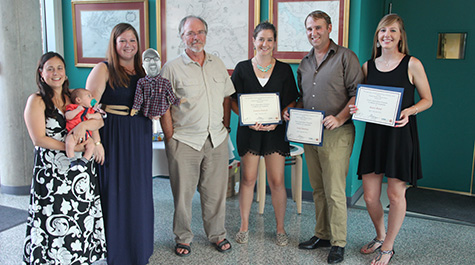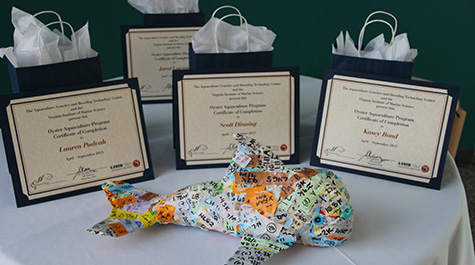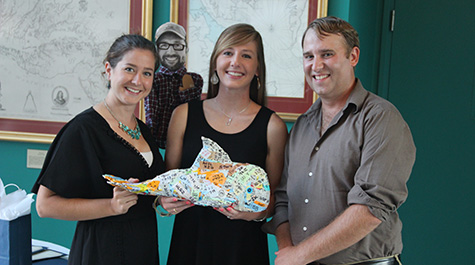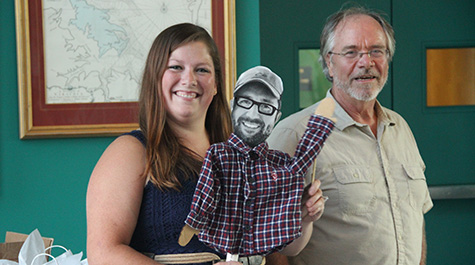VIMS prepares interns for careers in oyster aquaculture
Four emerging professionals needed to advance Chesapeake Bay’s rapidly growing oyster aquaculture industry received certificates of completion during a reception at the Virginia Institute of Marine Science last week.
The graduates were interns in the Oyster Aquaculture Training Program at VIMS. Created in 2009 by Professor Stan Allen, Director of VIMS’ Aquaculture Genetics & Breeding Technology Center (ABC), the six-month program is designed to help meet the increased demand for experienced and technical workers that rose with the spread of local oyster hatcheries and farms.
This year’s graduates were Kasey Bond of Bedford; Scott Dinning of Richmond; Jared Lawson of Floyd; and Lauren Pudvah of Beverly, Massachusetts.
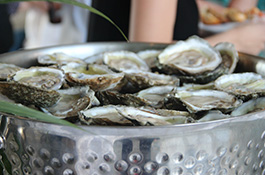 “The program gives the interns the skills needed to perform tasks in both oyster hatchery and field operations,” says Allen. “What’s more, each of the interns provides seasonal help that we’ve come to rely on during our busiest time of year."
“The program gives the interns the skills needed to perform tasks in both oyster hatchery and field operations,” says Allen. “What’s more, each of the interns provides seasonal help that we’ve come to rely on during our busiest time of year."
VIMS Hatchery Specialist Lauren Gregg says this year’s group of interns displayed an extraordinary level of ambition and enthusiasm. “They showed up every single day eager to soak up every detail that they could,” she says. “This drive and excitement about their work will help all four of them succeed in the field.”
Bond says she was ecstatic to find the OAT program when searching for a training program pertaining to oyster aquaculture. “It was exactly what I was looking for,” she says. “I couldn’t believe there was a paid internship through one of the most prestigious marine research institutions in the nation that would prepare me for my future in aquaculture.”
Pudvah says it’s important for VIMS to offer this program because the aquaculture industry is booming and trained workers are needed to continue its progress. Having recently worked at a hatchery for soft-shell clams, Pudvah came to VIMS to expand her hatchery knowledge and experience.
“My favorite aspect of the program was the different connections I was able to make with people in the industry,” says Pudvah. “I don’t think I could have received such a well-rounded experience like this anywhere else.”
Like Pudvah, Bond says an increasing demand for oysters makes skilled employees an imperative part of the equation for accelerating and improving the growing industry.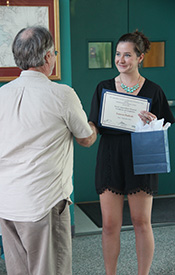
“I’m so grateful for the many connections I was able to make through the different externships we participated in at commercial hatcheries,” says Bond. “Working alongside leaders in the industry is an incredible learning experience.”
Bond—who recently accepted a position at Cherrystone Aqua-Farms on the Eastern Shore of Virginia—says “the OAT program confirmed that oyster aquaculture is more than a career for me; it’s a passion.”
Pudvah also plans to pursue a career in aquaculture, and says, “I plan to work in a private hatchery and eventually work in a resource management position.”
Dinning—who is currently finishing up his undergraduate degree at Virginia Commonwealth University and plans to enter the oyster aquaculture field immediately after graduating—says the entire program was fantastic, but that he most enjoyed his time in the algae room.
“The experience I gained at VIMS is invaluable,” says Dinning. “In a matter of months, the ABC staff taught us nearly every aspect of oyster aquaculture and helped us network with many of the industry’s leaders.”
“The day the interns start the program is like Christmas morning in the VIMS oyster hatchery,” says Allen. “We bring them right into the fold and they always become part of the ABC family, and this year was no exception.”
During the ceremony, Allen took a moment to recognize each of the interns for their accomplishments, and to bid them farewell as they embark on their futures in oyster aquaculture.
“Lauren—our first interviewee—showed so much determination, and even had a few offers from other hatcheries,” says Allen. “I’m very happy she chose our program.”
While recognizing Dinning for his unique contributions throughout the program, Allen admits they don’t normally accept individuals who are still in college. “We had to make an exception for Scott,” says Allen. “He was incredibly enthusiastic, and will do great things when he finishes up his degree.”
Allen admits they were also very impressed with Bond during the interview process. “We already had our three candidates chosen when Kasey came in as our last interview,” he says. “She came in with such natural confidence and a drive to excel in the aquaculture world. We know she will do a great job at Cherrystone.”
Lawson—who is currently completing an externship in Washington and was unable to attend the ceremony—is the first intern in OAT history to have a job lined up at a nearby hatchery prior to starting the program. “The industry is actually coming to us ahead of time now,” says Allen. “In Jared’s case, they came to us and said if you put him through the program, we will pick him up at the end.”
Funding for the Oyster Aquaculture Training program was made as an anonymous private donation to the Virginia Institute of Marine Science Foundation, a nonprofit 501 (c) (3) organization that supports the education and research missions of VIMS.

